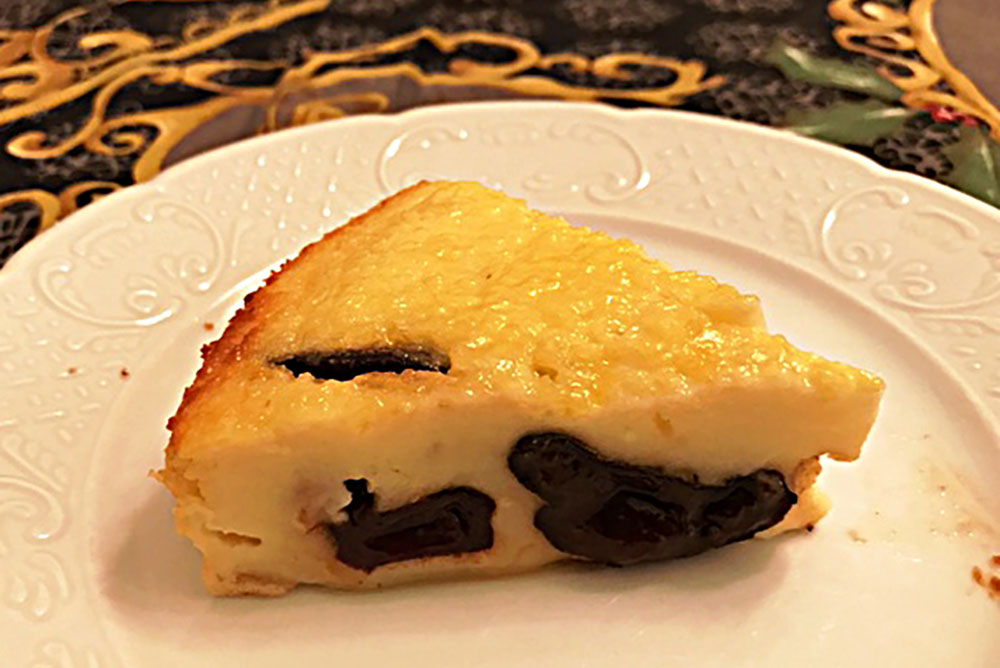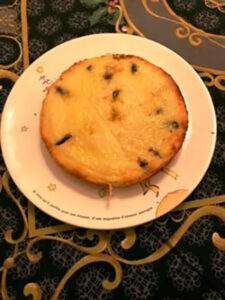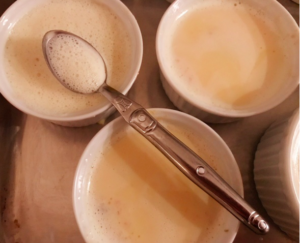
A classic Far Breton, made from a Daniel Boulud recipe. / Photo by Nancy Pollard.
By Nancy Pollard
After owning one of the best cooking stores in the US for 47 years—La Cuisine in Alexandria, Virginia—Nancy Pollard writes Kitchen Detail, a blog about food in all its aspects—recipes, film, books, travel, superior sources, and food-related issues.
 Childhood Prejudice
Childhood Prejudice
 MY YOUTHFUL introduction to prunes was less than felicitous. Since I had been diagnosed with an illness that precluded any citrus, my morning juice was not sunshiny orange but rather sludgy prune. As a special dessert, instead of forbidden lemon meringue pie, which was one of my mother’s specialties, I got prune whip. Trust me on this — there was no comparison. And, although it is a myth, I was sure there was prune extract in Dr Pepper when we were adolescents, which cemented my loathing of that beverage.
MY YOUTHFUL introduction to prunes was less than felicitous. Since I had been diagnosed with an illness that precluded any citrus, my morning juice was not sunshiny orange but rather sludgy prune. As a special dessert, instead of forbidden lemon meringue pie, which was one of my mother’s specialties, I got prune whip. Trust me on this — there was no comparison. And, although it is a myth, I was sure there was prune extract in Dr Pepper when we were adolescents, which cemented my loathing of that beverage.
It was not until I first went to France with the Resident Wine Maniac that I had a revelation. We were in a little country hotel with a restaurant (which we later discovered was a Relais & Châteaux member) and after a wonderful dinner, we were served “mignardises,” little sweet treats to have with coffee. One of these was a prune stuffed with a pistachio and almond marzipan. And in that moment of epiphany, I grew up about prunes.
Prune History & Sci Fi
Since the word “prune” in the US is still tainted with all the detriments I detested as a child, the wrinkly little things have been rechristened “dried plums” by PR geniuses, evoking associations with pleasant company like dried apricots, dried apples, and dried cherries. In France, plums are prunes, and prunes (or dried plums) are pruneaux. And the best ones we can get are labeled Agen. These prunes are the highest grade out of 46 of the Ente prune, which has a history going back to the Crusades, according to an article by Florence Fabricant in the New York Times. French soldiers brought a species of plum back from Damascus. They were planted by monks near Toulouse, who discovered how good the shriveled ones were that fell and were left on the ground. These Damascus plums were crossed with a local one, yielding what is now named the Ente plum, and these have been grown exclusively for the production of the famed Pruneaux d‘Agen. Ente plum trees were replanted in the area of Agen in the 17th century after severe frost decimated crops. These Agen prunes have been shipped worldwide for over two centuries.
Prunes need a little help from their friends, and Armagnac is a good bestie. Grab a large canning jar, fill it with the prunes of your choice, and top off with Armagnac. Try to wait about a month before spooning them over ice cream, or making one of the two dessert recipes below. And if you still turn up your nose at prune juice, look at this encounter between a Klingon and Bartender Whoopi Goldberg.
Warrior Recipes
 Rick Stein and his family run a small chain of top-notch restaurants in the UK. He also is a prolific cookbook writer. His restaurants are
Rick Stein and his family run a small chain of top-notch restaurants in the UK. He also is a prolific cookbook writer. His restaurants are  justifiably noted for their seafood. Should you be in a Rick Stein neighborhood, add it to your dining-out list. I think you will be pleased with their menu, service, and prices. I am still trying to make my Sole Meunière as good as the one served in his Winchester restaurant. This recipe, however, is a chicken recipe from one of his cookbooks, Rick Stein’s Long Weekends.
justifiably noted for their seafood. Should you be in a Rick Stein neighborhood, add it to your dining-out list. I think you will be pleased with their menu, service, and prices. I am still trying to make my Sole Meunière as good as the one served in his Winchester restaurant. This recipe, however, is a chicken recipe from one of his cookbooks, Rick Stein’s Long Weekends.
It is poached, and then added to a sauce of red onions and prunes, which you will begin constructing while the chicken thighs are simmering in a saffron bath. Criminally easy. This main course can be a mid-week meal or doubled up to be the main course for a party. It reheats easily and can be served with bread and a salad or with rice.
Kozani Chicken With Prunes, Saffron & Paprika

Put the chicken thighs in a large saucepan with the water and saffron. Bring to a boil and then turn down the heat so that the chicken pieces can gently poach for 10 to 15 minutes.
Remove the thighs to a plate and reserve the cooking liquid.
Heat the olive oil in a sauté pan that is large enough to hold all the chicken thighs.
Over medium-low heat, sweat the onion slices (I cut the onions in half and make thin half moon slices) until they are soft, about 10 minutes.
Add the paprika and cook for an additional 2 minutes.
Add the chicken thighs and about 23 ounces (700ml) of the cooking liquid.
Arrange the prunes in between the chicken pieces, season with salt and pepper and simmer for 20 minutes.
If the sauce is too watery, remove chicken, prunes, and onions to warm plate and reduce the sauce until you get a syrupy consistency, and add more salt and freshly ground pepper to taste.
Serve on warm plates with a spoonful of sauce on each chicken thigh.
- This recipe makes great leftovers!
- I prefer small chicken thighs.
- The original recipe calls for skinless thighs, but I have made it with both skinless and with skin on.
I know, I know, he is the head of a fancy-schmancy restaurant empire, but this title has many recipes that are truly accessible to the home  cook. Look at the blueberry sauce, for instance, or his Hanger Steak With Shallots (now my go-to recipe). His technique for the regional dessert called Far Breton is my favorite version. He has a few extra steps that make subtle differences in this very straightforward custardy cake, which uses prunes soaked in an Armagnac-based syrup. I use almond powder instead of flour to coat the butter in the pan or gratin. Having the ingredients at roughly the same temperature does indeed make a much silkier batter. And yes, like popover batter, it is better to let it rest several hours. I think it is important to either strain the batter before letting it rest overnight, or you could mix it in a food processor. Once you pour the batter in the pan, you add the prunes—and they stay somewhat suspended rather than gathering in a clump at the bottom. It really is a snap. Not bad for breakfast either. I have made this in a metal cake pan as suggested in the book and also in a ceramic gratin. The metal cake pan gives more of a crust, whereas the Far Breton exterior is softer when baked in a ceramic container. The cake-pan version I unmold, but the one in the gratin I just serve as is.
cook. Look at the blueberry sauce, for instance, or his Hanger Steak With Shallots (now my go-to recipe). His technique for the regional dessert called Far Breton is my favorite version. He has a few extra steps that make subtle differences in this very straightforward custardy cake, which uses prunes soaked in an Armagnac-based syrup. I use almond powder instead of flour to coat the butter in the pan or gratin. Having the ingredients at roughly the same temperature does indeed make a much silkier batter. And yes, like popover batter, it is better to let it rest several hours. I think it is important to either strain the batter before letting it rest overnight, or you could mix it in a food processor. Once you pour the batter in the pan, you add the prunes—and they stay somewhat suspended rather than gathering in a clump at the bottom. It really is a snap. Not bad for breakfast either. I have made this in a metal cake pan as suggested in the book and also in a ceramic gratin. The metal cake pan gives more of a crust, whereas the Far Breton exterior is softer when baked in a ceramic container. The cake-pan version I unmold, but the one in the gratin I just serve as is.
Far Breton

2 tablespoons (30ml) and ¼ cup (60ml) caster sugar
1 cup (237ml) water
6 ounces (170gr) pitted prunes
2 tablespoons (30ml) Armagnac
3 large eggs, at room temperature
Pinch fine sea salt
¾ cup (193ml) plus 1 tablespoon all-purpose flour
2 cups (473ml) whole milk, at room temperature
5 tablespoons (74ml) unsalted butter, melted and cooled
Bring the water and 2 tablespoons of the sugar to a boil in a small saucepan and allow it to dissolve together to make a syrup.
In a bowl, add the prunes and Armagnac, then pour over the sugar syrup in the saucepan. Stir gently and set aside to come to room temperature. Several hours is best.
In a mixer with the whisk attachment, over low-medium speed, combine the eggs, remaining ¼ cup sugar and the salt.
Gently mix in the flour, followed by the milk and finally the melted butter to make a batter.
Cover the batter with cling wrap and refrigerate for at least an hour. Overnight is better.
Preheat oven to 425F and butter an 8×2-inch (20×2.5cm) cake pan or gratin. Fit a circle of parchment paper in the bottom, and butter that as well.
Flour the interior of the pan, bottom and sides and tap out excess. (If I make the dish in a ceramic gratin, I do not use the paper, but rather butter and flour the gratin.)
Remove the batter from the fridge and stir it again to make sure it is mixed. Pour the batter into the pan.
Drain the prunes sitting in the simple syrup and drop them over the batter.
Put the pan on a middle rack in the oven and bake for 15 minutes at 425F before lowering the temperature to 350F.
Bake for another 30 minutes or a bit longer. The top should be a light golden brown and a knife inserted into the cake should come out clean.
Transfer the pan to a wire rack and allow it to cool to room temperature before running a knife around the edge.
You can serve it from the pan, or you can unmold it onto a piece of parchment on a plate. To do that, remove the parchment from the cake, and invert it onto a serving platter.
Serve immediately.
I usually use finely ground almonds instead of flour for lining the pan.
I use a Thermapen and when the temperature is 160-170F (or 71-77C), the cake is done.
Refrigerate leftover Far, covered, and have it for breakfast.
Henry Harris, Where Are You?

Skimming bubbles from the pots-de-creme.
This last recipe is my mash-up of the classic pot-de-crème recipe I learned from Mary Bond and a dessert that my husband adored at the now sadly closed restaurant Racine, in London, one of the lamentable results of posh neighborhoods being engulfed by wealthy absentee property-holders. My husband was so upset about its closing that he has vowed to search for the restaurant whereabouts of the chef Henry Harris. But let’s talk about happier subjects: prunes, Armagnac, and silky custard cream. If you follow my advice about storing some prunes in a jar of Armagnac, this is the perfect recipe to start with. When I learned how to make a proper pot-de-crème, you beat the eggs, milk, and cream with the paddle blade in the mixer so as not to create too much foam. Before ladling the mixture into tiny cups (I use ramekins now), you got rid of any foam or bubbles using a skimmer or spoon. I pop any remaining bubbles before sliding the pan into the oven. This recipe is super easy, but again the devil is in the details. Originally pots-de-crème were served on individual trays or plates in curved lidded cups: each person got three—mocha, lemon, or vanilla were the usual flavors.
Pots-de-Crème With Prunes

1 cup (237ml) whole milk
1 cup (237ml) heavy cream
¾ cup (178ml) caster sugar
2 whole eggs
2 egg yolks
1 teaspoon or more vanilla extract or about ½ teaspoon French Vanilla Essence
6 pitted prunes soaked in Armagnac, each cut into 6 to 8 small pieces for the base of each ramekin or cup
Instructions
Thermapen for greatest accuracy) and when it reads 170F (77C) the little custards are done. This should take 15 to 20 minutes. These custard creams should be wiggly and shiny on top.
If you store the pots-de-crèmes in the fridge, cover each with cling wrap. They store well for 3 days if kept this way.

 Childhood Prejudice
Childhood Prejudice